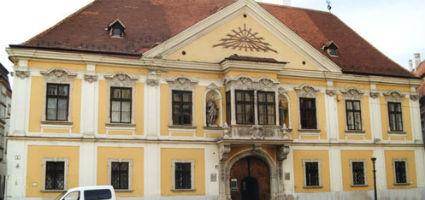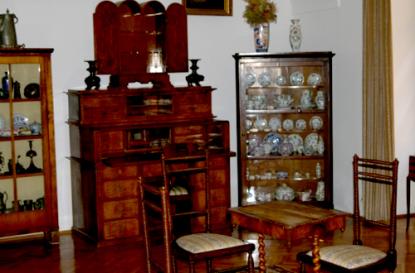2024. July 27. Saturday
János Xántus Museum - Győr
 |
Address: 9022, Győr Széchenyi tér 5.
Phone number: (96) 310-588
E-mail: xantus@gymsmuzeum.hu
Opening hours: 01.10-01.04.: Tue-Sat 10-16
|
Museum tickets, service costs:
|
Individual ticket for adults
|
800 HUF
|
|
|
Individual ticket for adults
(valid for the temporal exhibitions)
|
300 HUF
|
|
|
Individual ticket for students
|
400 HUF
|
|
|
Individual ticket for students
(valid for the temporal exhibitions)
|
150 HUF
|
|
|
Individual ticket for pensioners
|
400 HUF
|
|
|
Individual ticket for pensioners
(valid for the temporal exhibitions)
|
150 HUF
|
|
|
Ticket for families
|
1800 HUF
|
/ family
|
|
Season ticket for students
(school season ticket )
|
22000 HUF
|
/ half a year
|
|
Guide
|
3000 HUF
|
Dr. Abád József and his wife, Hauser Henriette, left their fine- and applied art collections to the Xántus János Museum of Győr.

Dr. Abád József (1910-1978) was a Secondary School teacher, later employed by the Hungarian Phisical Education University, the founder of volley ball association in Hungary and a significant sport diplomat. His wife kept his fine- and applied art collection and continued to develop it after the death of her husband. She was a PE teacher and was an outstanding figure in the nationalization of gymnastics. She and her husband both received the golden degree of Sports Medal.
Their collections was not built up consciously. Instead, the couple bought all interesting objects they liked to keep in their house around them.
The collection is shown interior-like. There are biedermeier furniture from the 18th century, porcelain, mainly from Herend, from the 20th century but also from Japan, a few objects from the east. There are also tin souvenirs from the 19-20th century, carpet from the 19th century and watches in the collection. The atmosphere is heightened by paintings: portraits, landscapes and mythological works.

Dr. Abád József (1910-1978) was a Secondary School teacher, later employed by the Hungarian Phisical Education University, the founder of volley ball association in Hungary and a significant sport diplomat. His wife kept his fine- and applied art collection and continued to develop it after the death of her husband. She was a PE teacher and was an outstanding figure in the nationalization of gymnastics. She and her husband both received the golden degree of Sports Medal.
Their collections was not built up consciously. Instead, the couple bought all interesting objects they liked to keep in their house around them.
The collection is shown interior-like. There are biedermeier furniture from the 18th century, porcelain, mainly from Herend, from the 20th century but also from Japan, a few objects from the east. There are also tin souvenirs from the 19-20th century, carpet from the 19th century and watches in the collection. The atmosphere is heightened by paintings: portraits, landscapes and mythological works.
